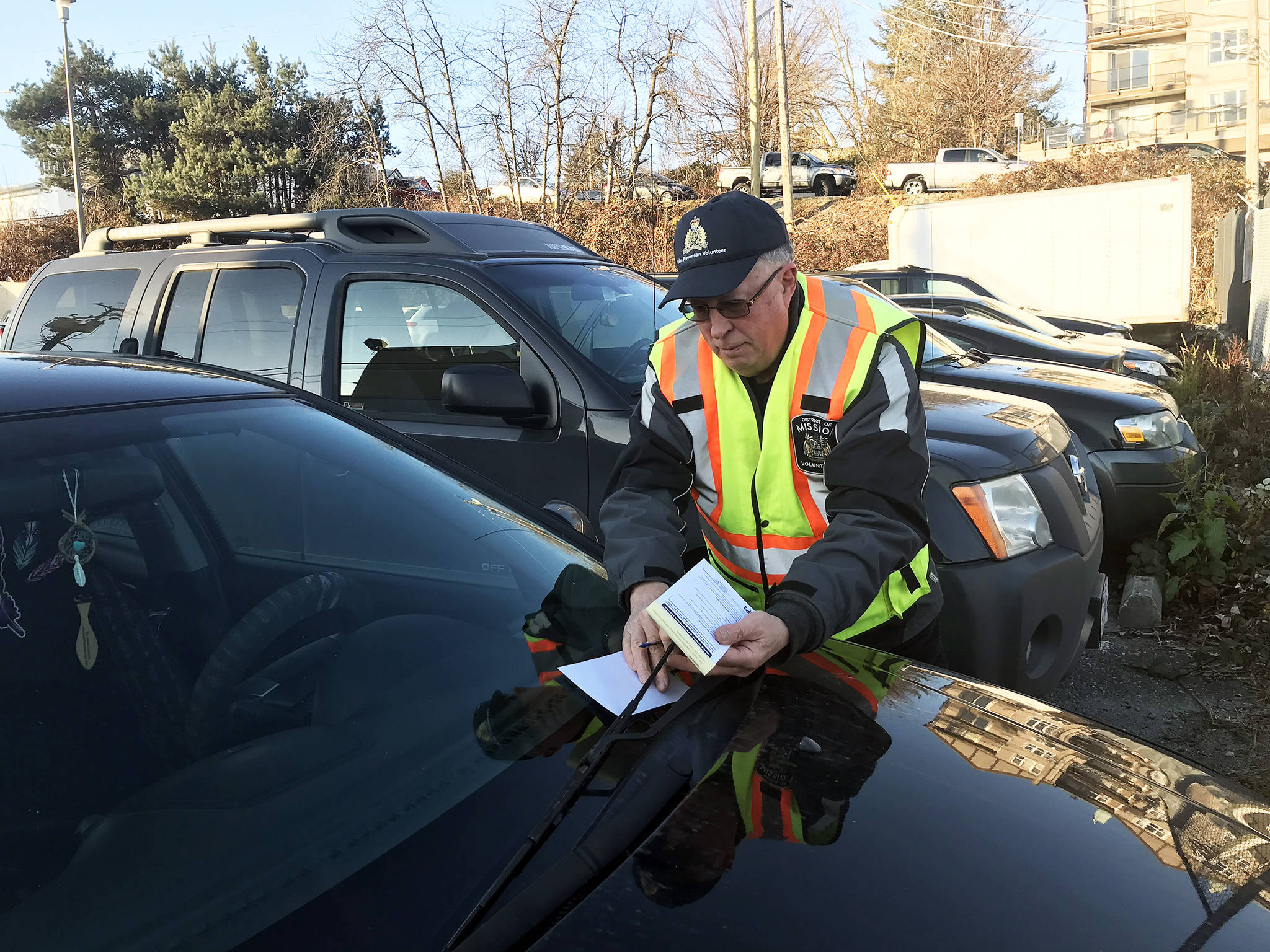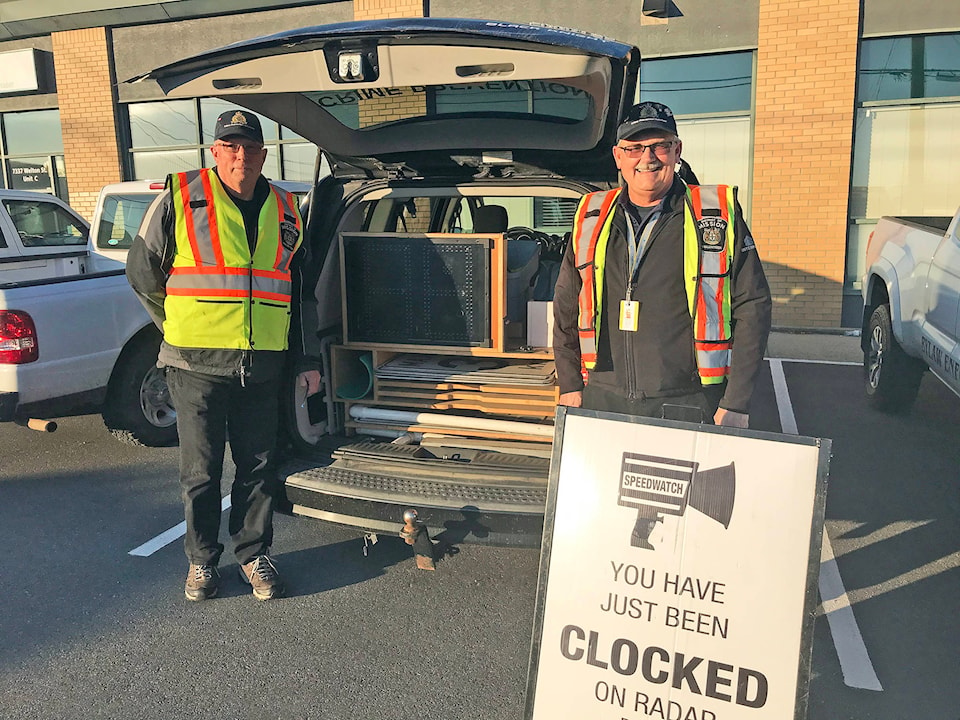Part Five in a five-part series on the inner working of the Mission RCMP
Anyone who has taken a stroll downtown has likely noticed the Mission Crime Prevention Office. However, few people know what services that office provides.
Local senior Dwight Elliott has been with the group for the past six years and recalls how he stumbled into it by accident.
“I had newly retired and I was walking downtown and saw the office. I didn’t know much about it so I came in,” he said.
Within weeks, his life had changed as be began training to help keep his community safe.
* * *
The Mission Crime Prevention Office is a joint project between the District of Mission and the Mission RCMP. Its main purpose is to help educate the community on how to avoid being a victim of crime.
It achieves this goal by running a variety of programs – using mostly volunteers – and by acting as an extra set of eyes and ears for the RCMP.
Part One – A constant cycle of information
Part Two – COMPSTAT: Sharing vital information
Part Three – Surveillance: Building a case
Part Four – General Duty: Working the night shift
“We focus on the crimes that affect the community as a whole – theft of vehicle, theft from vehicle, break-and-enter to residences and any petty thefts,” explained Jamie Nokes, former coordinator of Mission Crime Prevention Services.
The office runs programs like Block Watch – a program that encourages neighbours to join with others in reducing the likelihood of residential and property crime – as well as Crime Free Multi-Housing, Lockout Auto Crime, Citizens On Patrol and Speed Watch.
Nokes explains that Speed Watch is when volunteers set up a speed board to record drivers’ speeds. Volunteers write down the licence plate number of anyone who is speeding, and a letter is sent to the drivers.
“It’s just an educational piece; there is no enforcement,” Nokes says.
Volunteers also work with the RCMP at road blocks, running licence plates for the stolen car recovery system, and checking decals on the back of vehicles to ensure insurance is up-to-date.
While an employee of the district, not the RCMP, the coordinator of Mission Crime Prevention Services attends the regular RCMP Compstat (computer statistics) meetings to gather intel on hotspots of crime in the area.
The main areas they work with are stole vehicles, theft from vehicles, and break-ins.
One program, Crime Prevention Through Environmental Design, is growing in popularity. The program is offered to anyone who has been a victim of crime or just wants to improve security in their home.
An assessment is done when a volunteer or other representative goes to a house and looks at what crime has occurred and then discusses areas of concern that are noticed and could be fixed to limit the opportunity of crime occurring again.
“Sometimes it’s not easy for homeowners to see the areas of concern,” Nokes says.
Locking up sheds, moving bikes, moving ladders, lighting, fences, shrubs blind spots: anything like that could be altered to help make the home safer.
* * *
To run the various programs, a slew of volunteers are needed. Currently there are 55 volunteers, including office staff,who run the programs.
Shifts vary depending on the availability of volunteers. Dwight Elliott comes out for a four-hour shift two or three times a week.
He said in a four-hour shift, they can perform three sweeps of the downtown core.
“If we notice a car that has been reported stolen, we verify the plate number and call the police,” Elliott said.
The volunteers then back off and let officers deal with the situation. If the driver arrives back at the vehicle before the police, Elliott said they do not follow them.
“We are here to strictly observe.”
Volunteers perform foot patrols (not at night) and drive patrols, looking for any suspicious activity.
Elliott said it was difficult at first as some members of the public didn’t know about the programs. On several occasions people have yelled at him to get away from their cars, when he was looking at them.
“As time has gone on, the public has been much more amenable. Public awareness is getting higher.”
He laughs as he recounts the first time he worked with the Speed Watch team.
“Drivers were giving us, umm, gestures and yelling. Now people see us and give us a thumbs up because they know we are trying to keep people safe.”
There was a learning curve for the police as well.
“When I first got involved, the RCMP didn’t seem that interested in being involved with us … Now they are all friendly and really appreciate about us coming out and helping because they can’t be everywhere.”
* * *
Carl Koehler also volunteers his time with the Mission Crime Prevention Office. Like Elliott, he is retired and just wanted to help the community.
“When you’re in a community, you should try to give back a little bit. And I’ve always been interested in Block Watch,” he said.
While he assists in regular patrols, his main function is to act as a canvasser, trying to recruit people to join Block Watch.
There are currently 37 active Block Watch groups in Mission, 11 new groups and 620 total participants.
But they are always looking for more volunteers. They can be anyone who is available during the day, such as seniors and students. They even offer practicum opportunities for students through the University of the Fraser Valley.
Volunteers are all asked to have a criminal record check before they can begin.
While he enjoys his role on Block Watch, Koehler is also involved in Lock Out Auto Crime because it allows him to engage with people on the street.
“I try to help out everywhere – community events, anywhere we are needed.”
He said that when they check parked vehicles for expired stickers, stolen plates or even money and valuables left inside, they don’t just leave warning tickets.
“I also give thank-you notes as well as warnings. Everybody gets something.”
He also checks to ensure no animals have been left in the vehicles.
“It’s all-encompassing.”
Volunteers work in pairs and wear Community Engagement Team vests so people can easily identify them. On any given day, there can be two to six people on patrol.
Editor’s Note:
Shortly after these interviews were completed, Jamie Nokes resigned his position to pursue a different career path.

